Social Media Listening by industry
Social media listening by industry. Brands can track and analyze sentiment, increase brand awareness, follow trends, and benchmark against competitors.
February 9, 2024
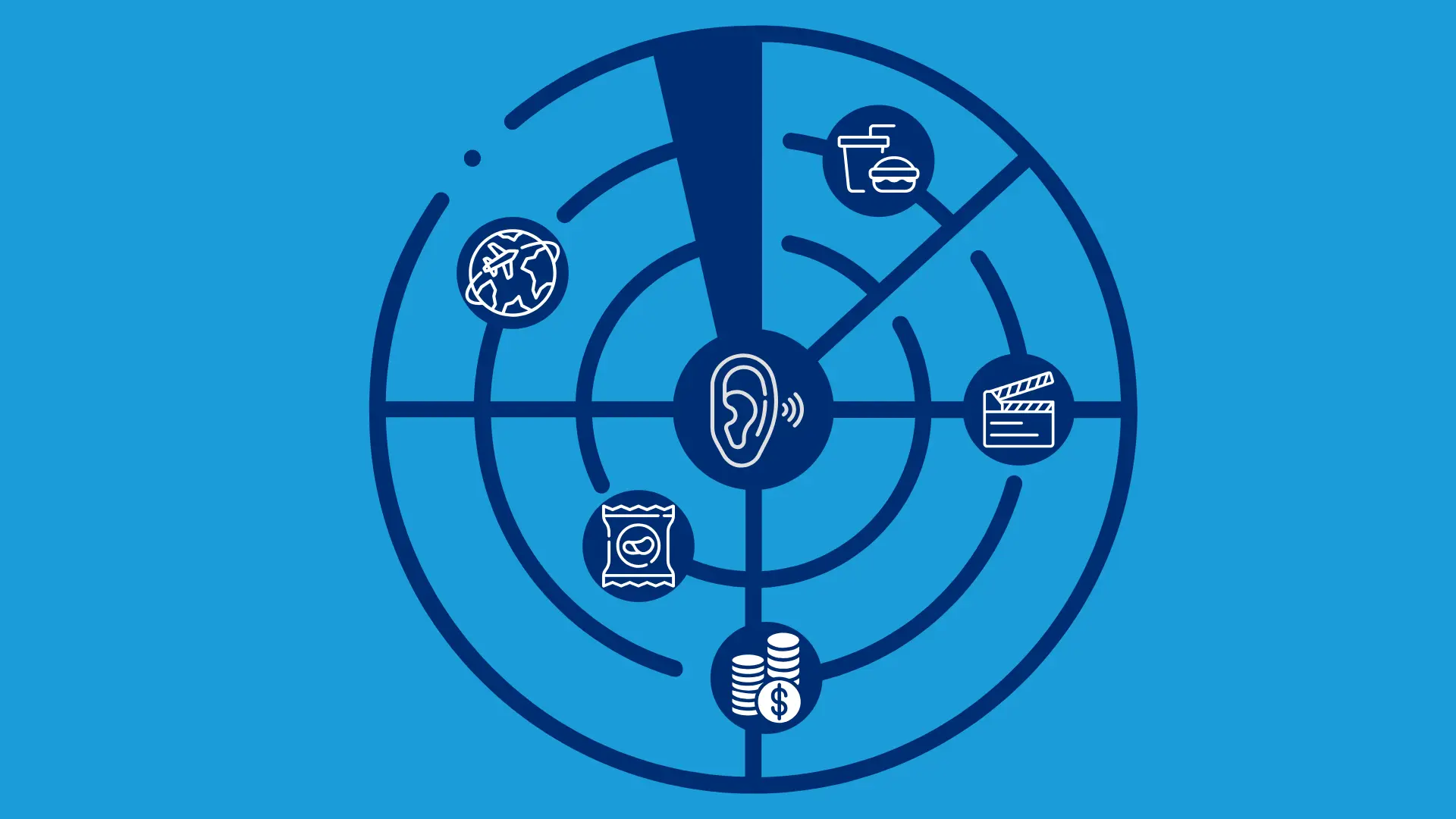
- Why social listening matters
- What is social media listening?
- Social listening vs social monitoring
- Why do brands use social media listening?
- Social media listening by industry
- Media & entertainment industry
- Travel & hospitality industry
- Financial services industry
- Consumer packaged goods industry
- Food & beverage industry
- Social media listening by your industry
- Additional Social Listening Resources
Customers are at the heart of your business. Understand them, engage them, and talk to them in the language they speak, and your business will fly.Ignore their input, and expect complaints, crises, and a loss of sales.How do you get it right? By using social listening for customer-focused insights. No matter your business or industry, if you want to better connect with your customers, social media listening will help. Read on to learn more.
Why social listening matters
Why have companies added social media to their marketing strategies? There are 4.70 billion social media users around the world, with 266M new users in the last 12 months alone. That’s potentially 4B+ potential customers. Consumers researching products like yours, and looking to buy online. They're online, and they're talking about your brand.Are you listening? If you want to understand consumers - likes, dislikes, pain points, interests, sentiment - social media listening helps you monitor conversations and analyze social data, to find actionable consumer insights. Gaining insights that’ll help you develop new products, find influencers, improve customer support, and outmaneuver your competitors. Regardless of industry.We’ve not included every industry as the post would be too long. So we've included 5 industries working with social media listening. The strategies they follow are not exclusive to those industries. They can be applied to others…{{cta('91430369778','justifycenter')}}
What is social media listening?
Social media listening collects data from social media posts so you can understand how consumers engage with your brand, product, industry, and competitors.Monitoring online conversations will help you identify what consumers think of your brand. What they’re looking for, and how to meet these demands. Finding positive and negative mentions will also alert you to an impending crisis, and find user-generated content to drive your marketing campaigns.Social listening can help you drive brand awareness, reputation, engagement, and revenue. When choosing your social listening tool, ensure it has the following features…
Sentiment analysis
Trend analysis
Image recognition
Video analytics
Speech analytics
Competitor analytics
Dashboards
Automated reporting
You can learn more about social listening in our complete guide:
What is social listening?Social listening vs social monitoring
Social media listening and social media monitoring tools will help you understand how consumers feel about your brand. When it's time to offer help. When you can have fun with a consumer. When you should say sorry. When to listen.
Social monitoring kicks off your social media listening strategy. Gathering all your social mentions and actions - share of voice, likes, shares, retweets, etc.
Social listening identifies and analyzes, finding patterns in data, tracking sentiment analysis, identifying influencers, and viewing themes that are driving results
Discover more about the difference between social listening and social monitoring.
Why do brands use social media listening?
If you don’t use social listening, you won’t know your audience. You’ll miss a consumer saying you’re awesome. You’ll miss a consumer saying you’re the worst. Your product team will be second-guessing what people want. Customers will turn to your competitors. Here’s some of the benefits of social media listening
Track social mentions
Tracking mentions on social media will identify positive and negative comments, so you can thank, apologize, and help. It’s equally important to find posts in which you’re not tagged, but do mention your brand. This is where image recognition, visual analytics, and speech analytics are crucial to your social media listening strategy.You can track specific keywords and topics, as well as competitor mentions, and industry news.You must collect the following data…
Which social platforms are your target consumers using?
Are there conversations about your industry?
How often does your brand get mentioned?
How often do your competitors get mentioned?
With this information, you can generate insights that will help you better understand your audience and the state of the market as a whole.
Monitor consumer sentiment
Monitor conversations related to your business, industry, and competitors so you understand how consumers feel about your brand, what they care about, and what they want. Positive feedback about your brand can be used in marketing campaigns, emails, or on your website. 80% of consumers say that user-generated content is more authentic, and influences their buying decisions. This makes it 8.7x more impactful than content from an influencer, and 6.6x more influential than content from a brand.If you find negative feedback about your brand, accept responsibility and apologize. If it’s something that can be fixed. Do it quickly. If the negative comment is public, responding and resolving quickly demonstrates to other consumers that you’re listening and acting on their concerns. Monitoring your industry means if you come across consumers asking for help, you can jump in and offer advice. Showing that you’re an expert will encourage consumers to contact you directly in the future, rather than attacking you in public.
Find the best influencers
94% of marketers use influencer marketing because it drives 11x more ROI than traditional marketing.Use social media listening to find influencers that are talking positively about your brand and products and nurture relationships with them. Build a stable of brand advocates to use in campaigns, to share your brand message, and promote your products.
Monitor competitors
What are consumers saying about your competitors?
How are they promoting their brand?
Are they targeting audiences that your brand could target?
What new products or features are they launching?
Social media listening as part of your competitor analysis plan will open up opportunities that you may have missed. Highlight mistakes to avoid. Identify what it is that consumers like about your competitors.
Social media listening by industry
Time to look at some real-life examples of social media listening by industry…
Media & entertainment industry
Netflix is a leading streaming provider. Its success isn’t just down to the content it provides. The team runs an awesome social media strategy, posting updates on upcoming movies and engaging in fun ways with its followers. This has been achieved by listening to its audience. Understanding what consumers want and meeting those demands. The brand has built a loyal community using social media listening.Netflix's social media strategy jumps on emerging industry trends that resonate with its audience and shares posts that invite its followers to participate and answer polls.The brand knows its consumers and gives them what they want.
Paging Mr. King to the nearest courtesy phone.We're due for an on-time arrival at 12:01am PT on November 4. Thank you for flying with us.— Netflix (@netflix) November 1, 2022
Using social media listening, Netflix identified an issue faced by its consumers. Falling asleep while binge-watching a program. While for most brands this isn’t an issue, Netflix wanted to demonstrate that it’s a brand that cares for its customers.To solve this frustrating problem, the brand launched tech-enabled socks that know when a viewer has fallen asleep and send a signal to the TV to pause the program. This initiative endeared consumers and earned the brand multiple awards.A trend analysis strategy will help you predict what’s coming, based on what’s already happened. You’ll collect data regarding marketing and sales performance, product development, spending, and more. The results will help you make data-driven decisions about future events.
Travel & hospitality industry
From a canceled flight to a double-booked hotel room, travel companies are using social media listening to help disgruntled travelers and understand consumer sentiment as a whole.But, it’s not just finding unhappy consumers. The travel and hospitality industry also uses social listening to identify what consumers want. Meal preferences on flights. In-flight entertainment choices. Hotel check-in times. New destinations.Looking to spend what can add up to a considerable amount of money, consumers spend time researching online, or reading consumer reviews. They want the best value for money. A memorable experience. This means your brand must have a positive presence online.
Airbnb drives positive sentiment
When COVID restrictions relaxed, holidaymakers started planning their escape. Between June 2021 and June 2022, mentions of Airbnb generated 4.8M results. Predictive analytics forecast this trend to continue to increase for the following three months. However, sentiment surrounding Airbnb was split between positive and negative at almost 20% each, with consumers expressing their concern about prices and safety.
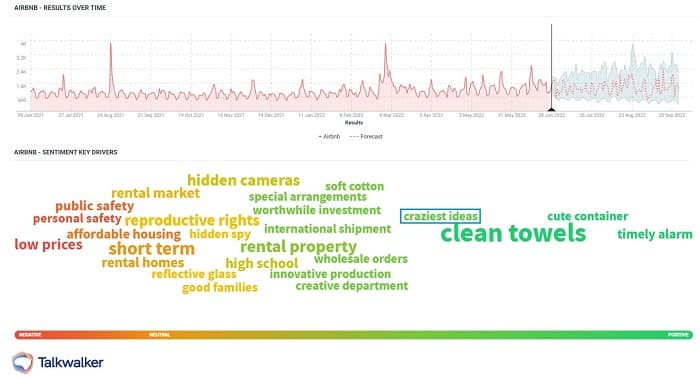
Predictive Analytics forecast Airbnb’s popularity would continue to grow over the following 3 months, while positive sentiment increased with the launch of the brand’s “craziest ideas” campaign.Not to be beaten, the brand launched the $10,000,000 OMG! Fund. The task was for people to build the craziest places to stay. The campaign quickly collected 2K mentions and positive sentiment increased to 26%.
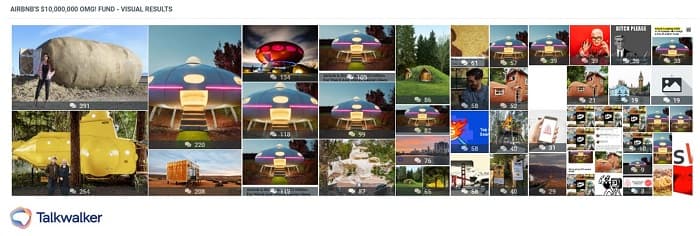
Visual analysis of Airbnb’s $10,000,000 OMG! Fund reveals the internet flooded with 2K results of the craziest places to stay.Airbnb listened to consumer concerns and in an effort to provide a better experience and give value for money, it showed how accommodation can be an exciting part of the holiday experience.To ensure that a brand isn’t being seen negatively and to find and answer consumer requests, a social media listening strategy should include…
Brand monitoring
Consumers research online when looking for new products. They read consumer reviews, check out comments on articles, and compare brands. This applies across industries. A negative comment from an unhappy customer can cause a consumer to dismiss your brand in favor of a competitor. Multiple negative comments and your brand could be doomed.You should use social listening to monitor sentiment - positive and negative - behind consumer comments. Look for conversations that talk about your brand but don’t tag you or use your branded hashtag, along with common misspellings or your brand. This ensures that you’re alerted to negative reviews in real time, enabling a quick reaction with an apology and solution to the issue. Deal with the problem efficiently, and it’s possible to turn a negative into a positive, building customer loyalty while demonstrating that your brand cares.Brand monitoring is critical. To protect your reputation, monitor your competitors and industry, product development, and more.
Lead generation
Monitoring potential customers’ conversations sets you up for finding new opportunities. For example, you’re looking to target consumers who want to travel to the UK. You need to grab their attention before your competitors. Social media listening allows you to monitor their public conversations and find mentions of their desire to visit the UK. You can then contact them directly with a personalized message and offer, so you’re their first choice of hotel/tour operator/activity.Following their trip, be sure to reach out for a review. It’s essential customer feedback if you're looking to develop new offerings and streamline the customer experience. Check out How to collect customer review data for more details.
Competitor analysis
We know we have competitors. We follow them on their social media channels, read their blogs, and maybe check out their reviews. Competitor analysis is more than that. For instance, your hotel is normally at its busiest in the summer months. But this year you’re experiencing a slump. Bookings are down and it’s damaging your bottom line. You check out the competition to see if they’re experiencing similar issues, only to see that your main competitor has a promo running through June and July, offering a big discount. A social media listening tool would have alerted you to your competitors’ strategy in real-time, meaning you could have matched or beaten the offer. A performance benchmarking strategy will show you how your brand stacks up against your competitors, comparing it with best-in-class standards.
Financial services industry
The finance industry is fast-paced and constantly evolving, never more so than over the last couple of years. While the majority of consumers moved online for their banking needs some time ago, the pandemic accelerated this shift as we were forced to stay home. This means that there’s an increasing number of people who’ve never visited a physical bank. Social media listening helps financial services address this change in consumer behavior and provide a digital experience that ensures customer satisfaction and loyalty.
Market trend analysis
Tracking hashtags, as well as competitor and consumer insights, will ensure your brand remains current about socio-economic market trends. This will enable you to create a marketing strategy that can be adapted quickly to meet new demands.Monitoring consumer insights will also keep your SEO strategy relevant. A search engine crawling your website will look for keywords that answer a user’s search. As new banking features are launched or consumer language shifts, it’s crucial that you incorporate these new keywords on your website. People have changed how they bank. Traditional banking is still relevant, but digital banking is on the increase. Check out 11 marketing strategies for financial services.
Drive customer satisfaction & online reputation
The consumer experience you provide will determine customer satisfaction and the strength of your online reputation. A social media listening plan helps brands understand consumers. The consumer journey towards conversion, and any pain points they experience on the way. Meaning the customer experience can be enhanced and CSAT improved.
Consumer packaged goods industry
Way back when, the CPG industry marketed to mass retailers like Costco, John Lewis, Walmart, and Target. But the industry and consumers changed and now, CPG brands also market directly to consumers. This means consumer behavior and preferences have to be understood. Consumers are on social media platforms making purchases and leaving valuable social data across platforms, meaning social listening has become a crucial tool for the CPG industry to collect product insights and purchasing habits. The CPG industry uses social media listening to…
Identify popular varieties of a product
Any brand that tries to guess what consumers want, without research, is likely to experience a product launch failure.
Coca-Cola strike!
Coca-Cola and Pepsi rubbed along quite peacefully for years. That was until the Pepsi Challenge in 1975. A blind taste test to find out which brand consumers preferred.Pepsi came out on top and Coca-Cola’s market share dropped. In its fight back, Coke introduced Diet Coke and caffeine-free Coke. The public lapped them up. But when Coke spent millions updating its original recipe - New Coke - consumers turned up their noses. Unpopular Opinion...New Coke wasn't that bad. 🤣Am I the only one? LOL#80sCoke #NewCoke pic.twitter.com/hASvGGptjV— 80s Fashion & Culture (@80s_fashion) February 10, 2022After New Coke was wholly rejected, the brand returned to its original recipe, restoring its previous sales records and beating Pepsi.Lesson to be learned?Fair enough, social media wasn’t around for the initial Pepsi Challenge, but market research has been around for decades. Nowadays, Coke could have used social media to test the water. Listened to consumer feedback and avoided this hit to its reputation as the leading fizzy pop brand.
Lay’s home run
CPG brands use social media listening to help with product development. To find out what consumers want, rather than guessing.In 2021, Frito-Lay - US potato chip brand - launched a campaign on social media inviting consumers to submit flavor ideas. The goal was to increase sales by 3%.
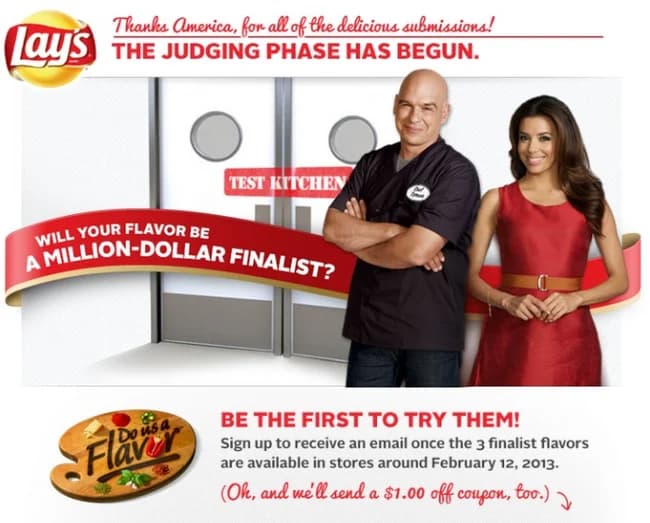
The brand invited consumers to participate in product development.After entering their choice, consumers received an image of a Lay’s bag customized to show their flavor. The intention was for consumers to share the image on their personal social media accounts.During the 10 months the campaign ran, the brand received 3.8M suggestions, with the Lay’s Facebook page receiving 22.5M visits per week. The lucky winner received $1 million.Did Lay’s achieve its 3% target?Big time. Sales increased by 12%.Lay's #DoUsAFlavor is back! Pitch us your flavor idea for a chance to win $1 Million!! #Lays https://t.co/SEJyH6iY8X pic.twitter.com/8WAco1Xcqa— LAY'S (@LAYS) January 10, 2017The brand listened to consumers and developed its product according to demand.Social media listening allows brands to monitor brand mentions and consumer sentiment toward their products. Identifying negative comments about a product means brands can quickly modify the product to meet consumer expectations. Setting up alerts with brand/product names and common negative phrases - tastes disgusting, too much sugar, bland, etc., helps CPG brands update and improve their recipes.CPG brands can also monitor shifts and trends in the industry to identify new products or services - flavors, types of beverages, health requirements, and regulations.
Crisis management
A crisis can come out of nowhere. No brand is safe. But, social media listening helps brands spot a crisis before it can cause long-term damage to their reputation. Yorkshire Tea were quick to react and found the right tone to tackle a crisis that saw the brand caught in the crossfire…
Yorkshire Tea’s storm in a teacup
Yorkshire Tea has a cracking social media management team. Sharing fun, informative social posts in a sincere tone of voice, and regularly engaging with conversations. Listening and reacting quickly if a potential crisis emerges.The brand unfairly suffered a backlash when former UK Chancellor of the Exchequer/current UK PM, Rishi Sunak, posted an image of himself on Twitter with a large bag of Yorkshire Tea bags. Quick Budget prep break making tea for the team. Nothing like a good Yorkshire brew. pic.twitter.com/zhoQM9Ksho— Rishi Sunak (@RishiSunak) February 21, 2020I’m guessing that Sunak thought his post would help promote the idea that he can relate to people in the north of England because he’s drinking tea from Yorkshire.Go figure!Oddly, the bulk of the backlash attacked Yorkshire Tea as opposed to the former Chancellor of the Exchequer/current UK PM/not sure what’s next. Consumers accused the brand of having an endorsement deal with the Tory government.Listening to social media, Yorkshire Tea’s social media team reacted quickly with a human, light-hearted response.So it's been a rough weekend.On Friday, the Chancellor shared a photo of our tea. Politicians do that sometimes (Jeremy Corbyn did it in 2017). We weren't asked or involved - and we said so the same day. Lots of people got angry with us all the same. pic.twitter.com/7uVmKDf7Jd— Yorkshire Tea (@YorkshireTea) February 24, 2020Yorkshire Tea was listening and reacted quickly.Following up after the weekend with more.
Food & beverage industry
The food & beverage industry deals directly with consumers. And what a fickle bunch we are.Need a burger now! Looking for a healthy alternative. Is cauliflower the new meat? Can courgettes replace pasta? Do you use oat milk?F&B brands must stay on top of trends to survive. That's why the industry recognizes social listening as the most efficient way to understand consumer behavior, preferences, and grievances.In the past, while market research was effective, social media amplified consumers' thoughts in real-time on the largest public forum in the world.This instant feedback helps brands identify trends, complaints, suggestions, etc. Allowing food & beverage brands to react quickly to potential product recalls, packaging issues, health & safety complaints, product suggestions, and more. Monitoring consumer conversations also offers partnership opportunities. For instance, customers who favor a particular cola brand with their Domino's pizza.
Starbucks asks & listens to consumers
Starbucks uses market research and social media listening to understand its audience and meet the ever-changing demands.My Starbucks Idea was launched in 2008 on the brand’s website. Consumers and employees were asked to submit suggestions for new flavors, new products, old product requests, improvements, etc.
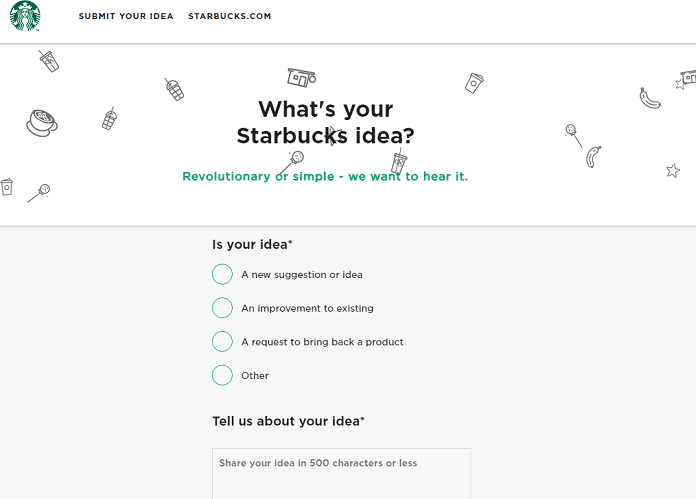
Starbucks asks consumers for new product ideas.One popular suggestion was that the brand includes dairy-free milk in its product line. The trend for dairy-free milk products was already growing so Starbucks reacted swiftly and launched drinks using almond milk, coconut milk, and oat milk.The brand’s social media listening strategy includes asking consumers questions and monitoring online conversations on Facebook, Twitter, Instagram, etc., to understand how consumers feel about the brand and its products. Consumer feedback is collected and used to direct brand and product improvement.
Taco Bell spices up engagement
Mexican food chain Taco Bell uses social media listening to find product inspiration and to engage and build relationships with consumers. The brand’s social media team retweets every positive comment, joins fun conversations, and posts engaging messages. It also responds quickly to customer complaints.__CONTENTFUL_EMBED_2__
Social media listening by your industry
Regardless of industry, brands have to understand their audience to be successful. Social media provides a global market research platform… in real-time. Your social media listening strategy will show you what consumers think and say about your brand, and help you attract and retain consumers. Along with the industries I’ve included in this blog post, check out some case studies from customers in other industries who are using social media listening…
HelloFresh uses social data to track influencer mentions, improve recipes and delivery routes, and keep track of trends and competitors
A pharmaceutical company used social listening strategies to find the emotions, motivations, and challenges experienced by MS patients
Orange telecom uses social media listening to understand customers in different markets
Grubhub uses consumer insights from social media to improve and inspire the food experience
If you’re not using social listening yet, it’s not too late. Start monitoring consumer conversations on social networks now to activate and support…
Crisis management
Product development
Customer care
Brand advocacy
Trend analysis
Customer engagement
Customer satisfaction
Reputation management
Lead generation
Sentiment analysis
Competitor analysis
To discover more about social listening and how it can help your brand, click below.{{cta('91430369778','justifycenter')}}
Additional Social Listening Resources
What is social listening important?7 inspiring social listening examples for brandsMastering social listening: tips and techniquesHow to create a social media report
